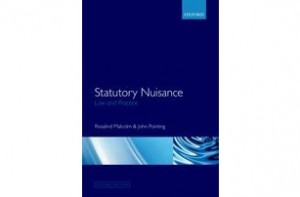Statutory nuisance remains a complex and difficult area of law, especially when nuisances originating from industrial, trade and business premises are alleged. Here the issues are likely to be more complex, the solutions elusive, and best practicable means defences may be hard to rebut by the local authority. (By John Pointing, Barrister and Legal Partner at Statutory Nuisance Solutions).
 |
| [relatedPosts title=”Related Posts”] |
|
|
The necessity for local authorities to carry out a proper balancing exercise between the rights of commercial users and residents, and to apply the concept of “reasonable user” properly, are just as important today as in the 1850s, when statutory nuisance legislation was first enacted.
It has taken Rosalind Malcolm and me over two years to write this second edition of our book, which was first published in 2002. Quite a lot has happened since. The law concerning public nuisance is clearly separated from private nuisance since the decision of the House of Lords in R v Rimmington and Goldstein [2005]. New statutory nuisances involving artificial light and insects have been created by legislation, with significant variations emerging between the laws of England and Wales as compared with those of Scotland and Northern Ireland. Environmental health practice has come under the scrutiny of the courts – and has sometimes been found wanting – for example in cases like R (on the application of Hackney LBC) v Rottenberg [2007] and Elvington Park Ltd v City of York Council [2009]. Expert evidence does not always assist the court to make the right decision.
The quality of evidence needed to prove the existence of nuisances has also come under the withering scrutiny of the courts. In Barr v Biffa [2011] EWHC 1003 (TCC), a recent odour nuisance case involving a waste facility, Mr Justice Coulson had this to say:
“A claimant who failed to make any contemporaneous complaints or records (or anything other than a handful of such complaints or records) over the five year period with which I am concerned, cannot begin to demonstrate that the odour which he or she experienced was beyond an acceptable threshold or starting-point. The absence of significant complaints or contemporaneous records merely demonstrates that those 23 claimants … considered that such odour events as they experienced were tolerable and not beyond the ordinary ‘give and take’ (para 445).”
What we have wanted to do in the new edition is to focus on the practice issues facing legal advisers and EHPs working in environmental protection. Besides analysing each form of statutory nuisance in detail, we also provide guidance on local authority duties, service of abatement notices and proceedings in court. For further information, please consult the second edition of our book, available here. For advice on legal and technical matters please visit our website: http://www.statutorynuisancesolutions.co.uk/
.




